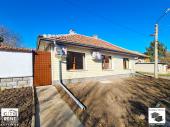|
| 3D models preserve masterpieces of secession architecture in Bulgaria |
|
|
 A new architecture style called secession emerged at the end of the 19th and the beginning of the 20th century. It is known as Art Nouveaux in some countries and Jugenstil or Modern in other. It left its mark in plastic art, architecture, the interior and the furniture design. The secession was influenced by the Japanese, Oriental and Byzantine art. Some popular Bulgarian buildings such as the Sofia Central Mineral Baths, the Synagogue and the former Atanas Burov Bank were built in that period. These buildings were made by celebrated Bulgarian architects who returned to their home country from Prague, Vienna and Paris after the Liberation from Ottoman Rule in 1878. They became part of the new urban planning of the Bulgarian capital. Nikola Lazarov, Georgi Fingov, Petko Momchilov, Kiril Marichkov and Pencho Koychev are among the architects who changed entirely the appearance of Bulgaria’s capital. Today, many of their masterpieces are in decay, because of the unwillingness or the financial impossibility of their owners to maintain their authentic look. Thus, little by little the Bulgarian cities are losing their authentic look and turning into a weird mixture of buildings of different style.
A new architecture style called secession emerged at the end of the 19th and the beginning of the 20th century. It is known as Art Nouveaux in some countries and Jugenstil or Modern in other. It left its mark in plastic art, architecture, the interior and the furniture design. The secession was influenced by the Japanese, Oriental and Byzantine art. Some popular Bulgarian buildings such as the Sofia Central Mineral Baths, the Synagogue and the former Atanas Burov Bank were built in that period. These buildings were made by celebrated Bulgarian architects who returned to their home country from Prague, Vienna and Paris after the Liberation from Ottoman Rule in 1878. They became part of the new urban planning of the Bulgarian capital. Nikola Lazarov, Georgi Fingov, Petko Momchilov, Kiril Marichkov and Pencho Koychev are among the architects who changed entirely the appearance of Bulgaria’s capital. Today, many of their masterpieces are in decay, because of the unwillingness or the financial impossibility of their owners to maintain their authentic look. Thus, little by little the Bulgarian cities are losing their authentic look and turning into a weird mixture of buildings of different style.
Three young Bulgarians, who realized the importance of the architecture monuments in the urban landscape, created a project aimed at directing public attention to the problem in an unconventional way. The idea of architect Konstantin Dimitrov, film producer Kaloyan Nikolov and theatre director Lubomira Kostova was financed by the National Culture Fund. It envisages the creation of nine 3D models of secession buildings situated in Ruse, Varna, Pleven, Plovdiv and Sofia. The three Bulgarians focus their attention on secession, because the national romanticism in Bulgaria evolved from this architecture style. It is characterized by the combination of architecture elements of the Bulgarian Medieval architecture – combination of light and dark brick layers, together with the floral motifs which are typical of the secession style.
We are planning to launch an added reality exhibition. For the purpose, these 3D models must be processed and uploaded in a special application, Lubomira Kostova says. From then on, the exhibition could be held anywhere in the world.
Travelling outside the capital helps them learn more about the history of the filmed buildings. During one of their trips to Plovdiv, Lubomira, Konstantin and Kaloyan learned that a summer house in the city center was once a favorite recreation spot of renowned Bulgarian writer Ivan Vazov. The owners of the property do not take the necessary care of the summer house and this place may share the destiny of many dilapidated architectural monuments. The photogrammetric photos which are used during the creation of the 3D models will preserve this architectural wealth for the future generations. Thus, our project has an educational function as well, Lubomira says. This is so, because these types of models recreate the buildings in their authentic look and make them visible to the broad audience.
This type of photogrammetric scanning of old buildings is popular in Europe, Konstantin Dimitrov explains. It is used not only for exhibitions, but to make archives of old buildings. It can be also used as an architectural pad for design during restoration. These are the so-called BIM models which have been gaining popularity and are becoming a standard in architecture design. They are a digital copy of the future building with all its elements – architecture construction and installations.
The photogrammetric scanning of a building is not cheap, but this investment pays off, Lubomira contends. For instance, the world-famous Paris Cathedral Notre Dame will be restored thanks to such scanning which was made for a computer game several years ago. |
|
|
Source:
bnr.bg
|
| Friday, Aug 02, 2019 |
|
|
|
|
| » RENTALS |

|
|
|
| House |
€ 550 |
|
| Location: |
Veliko Tarnovo |
|
|

|